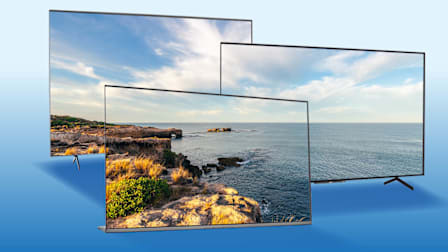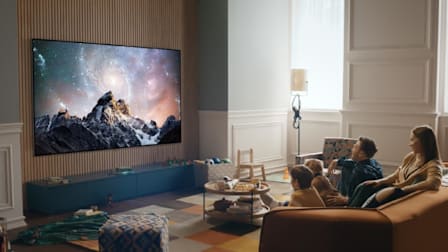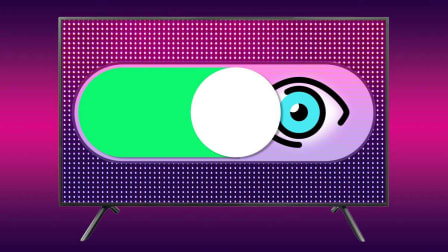Watching TV While Blind
Making television accessible to people with vision impairments requires technical and regulatory advances and collaboration to ensure visual media remain open to all

In 1985, there was not a 7-year-old on the planet with a better working knowledge of the goings on in Genoa City, the fictional setting of “The Young and the Restless,” than me.
The daytime drama was my grandmother’s favorite. It was my job to watch with her and provide visual commentary, because my grandmother was blind. When the words weren’t enough, I helped her set the scene in her mind by answering her questions. “Were his eyes opened when they kissed?” she’d want to know. “Can anyone in the courtroom tell she’s lying?” We played this game of TV Show and Tell whenever the set was on.
Back then, no one thought much about how to make TV accessible to visually impaired people, or really even considered that it might be an important thing to do. Today the landscape is vastly different. Newer TVs have settings and features designed to help people with limited vision enjoy the boob tube like the rest of us. Still, disability advocates say these assistive technologies leave room for improvement and that laws surrounding their implementation are not keeping pace. At the same time, they say, the need to make devices even better and easier to use by the visually disabled is more pressing than ever.
Regulating Accessibility
That a person like Paul Castle with low or no vision can enjoy television today has been a project decades in the making.
In 1990, the pioneering Americans with Disabilities Act prohibited discrimination on the basis of disability, with a suite of laws covering everything from employment to public accommodations.
But it wasn’t until 2010 that the 21st Century Communications and Video Accessibility Act mandated that telecommunications companies and video programmers ensure that new digital, broadband, and mobile innovations adhered to accessibility laws. Among other things, the CVAA required that emergency information be conveyed in a manner accessible to people who are blind or visually impaired and that TVs and other video devices have a button for activating audio descriptions. And yet, more than a decade after that law’s passage, only the largest 90 of the 210 broadcast market areas presently provide audio-described content and emergency notices.
And it wasn’t until 2012 that the Federal Communications Commission required all local broadcasting services in the U.S. to offer a minimum of 4 hours of secondary audio programming (SAP) for visually impaired viewers every week. SAP is an auxiliary audio channel that, in addition to having different languages, provides descriptive audio narration of visual information that can be broadcast or transmitted both over-the-air and by cable television.
Furthermore, the requirements do not apply to video streaming applications, meaning platforms like Hulu or Netflix, both of which do provide accessibility tools by choice, are not bound by regulation to adhere to accessibility requirements. In July, Sen. Ed Markey (D-Mass.), the author of the original CVAA, along with Rep. Anna G. Eshoo (D-Calif.), introduced the Communications, Video, and Technology Accessibility (CVTA) Act, as an effort to update existing accessibility regulations and make them inclusive of technology not conceived of more than a decade ago.
Jeff Wissel, chief accessibility officer at Disability:IN, a nonprofit resource for disability inclusion, is happy to see accessibility requirements continue to advance. “When all these aspects come together, it enhances the experience for those of us with disabilities to fully participate,” he says.
Read "Trouble Seeing Your TV? Try These Settings for People With Vision Impairments" to learn how to use audio descriptions, high-contrast modes, and other accessibility features.
Roadblocks Remain
One barrier to participation expressed by many in the visual disability community is the lack of default accessibility settings for new devices. Rather, most have accessibility settings that must be opted in to, posing a significant challenge to individuals who can’t read a manual or navigate through settings onscreen. A more frictionless option for the visually impaired would be accessibility settings as the default users could choose to disable.
Nearly a decade ago when Danielsen, at the National Federation of the Blind, found himself unable to independently set up his new television, he had to call for backup. “My friend had to come over and help me install it and set it up because I couldn’t walk through the screens,” he says.
Disability:IN’s Wissel says that even today TV manufacturers, as well as content creators, need to do better. “There are many companies that have yet to fully embrace the requirements to ensure their products and services meet the accessibility requirements,” he says.
Still, no one doubts that members of the visually impaired community are reaping huge benefits from the advancements in television technology and content creation we’ve seen. Today, most smart TVs—essentially traditional sets that connect to the internet—allow access to multiple streaming video services, such as Amazon Prime, Netflix, and Hulu, which all have accessibility features like closed captioning and audio description. And many new smart TVs have the added benefit of being voice-enabled, allowing for operation and navigation independent of onscreen menus.
It is important to note that people with visual impairments are not a monolith, and there is no universal solution for how a television may best work for everyone. Whether their disability stems from genetics, age, or incident, an individual’s unique circumstance will define what option is best for them.
But there are certain products that do provide an accessibility edge, and there are things to know about how to use the settings in the TV you presently own—or a new one you plan to buy—to make it work optimally for you. “Fortunately, we’re seeing more TVs that have accessibility settings, and some companies seem genuinely interested in moving beyond what is simply required by law,” says Jim Willcox, CR’s senior electronics editor.
































